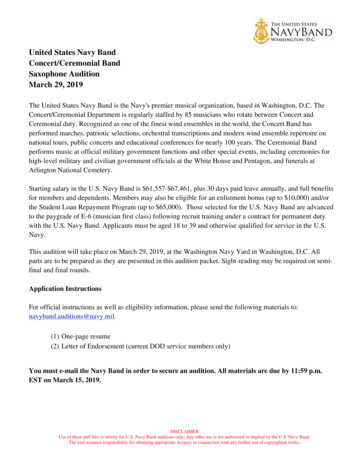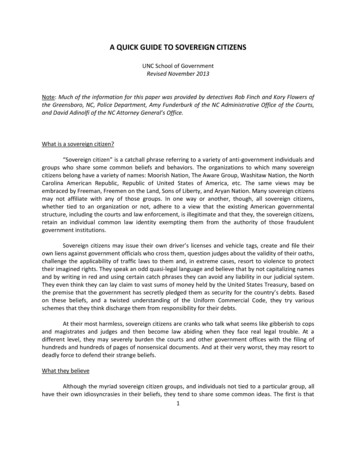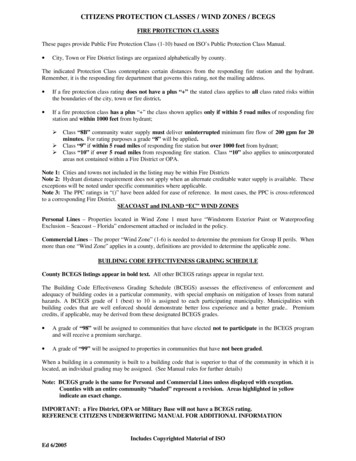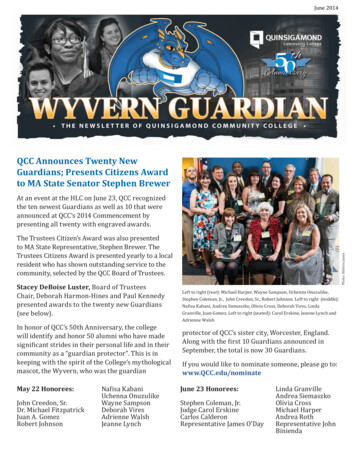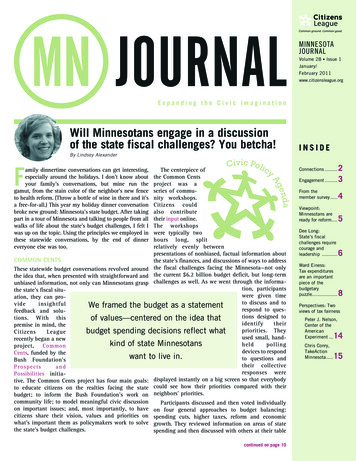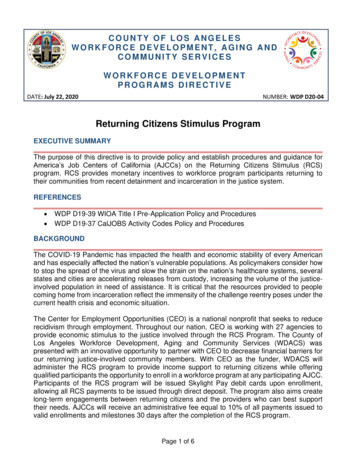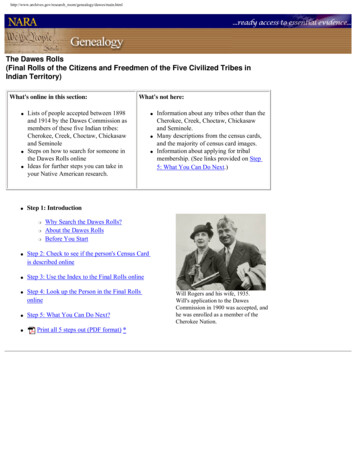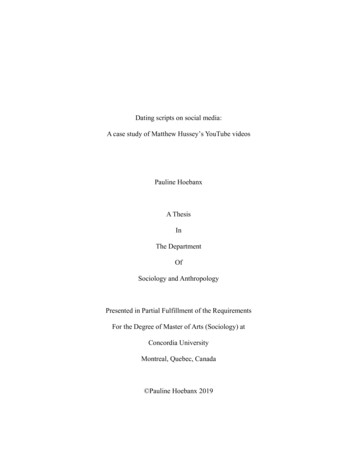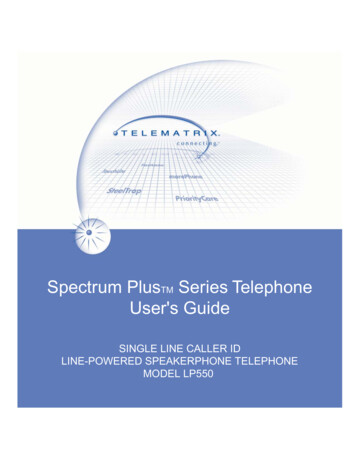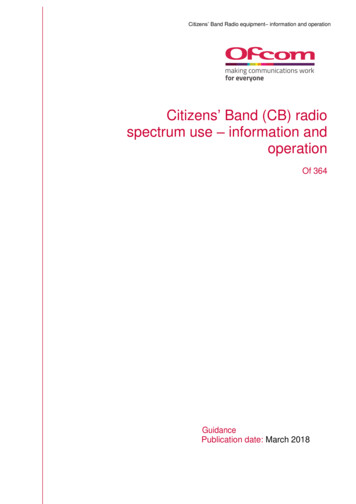
Transcription
Citizens’ Band Radio equipment– information and operationCitizens’ Band (CB) radiospectrum use – information andoperationOf 364GuidancePublication date: March 2018
Citizens’ Band Radio equipment– information and operationContentsSectionPage1Regulatory and equipment information12Frequently asked questions53CB operating practice8
Citizens’ Band Radio equipment– information and operationSection 1Regulatory and equipment informationCitizens’ Band (‘CB’) radio1.1Citizens’ Band (‘CB’) radio operates in the 27 MHz band. It is a short-rangeradio service for both hobby and business use. It is designed to be used withoutthe need for technical qualifications. However, its use must not causeinterference to other radio users. Consequently, only radios meeting certainspecific requirements may be used. These are described below.How Ofcom authorises the use of CB radio1.2Ofcom seeks to reduce regulation, where possible. In 2006, we therefore madeexemption regulations1, removing the need for a person to hold a licence to operateCB radio equipment using Angle Modulation (FM/PM).1.3In 2014, Ofcom made further exemption regulations2, which permitted theoperation of CB radio equipment using two additional modes of AmplitudeModulation (AM) - Double Side Band (DSB) and Single Side Band (SSB). Thisfollowed an international agreement3 made in 2011.”.1.4CB users share spectrum in a frequency band used by the Ministry of Defence(MOD). CB users must therefore accept incoming interference caused by use ofthis spectrum by the MOD.1.5CB radio equipment must be operated on a 'non-interference’ basis. This meansthat its use its use must not cause harmful interference to other authorised uses ofradio.1.6It is an offence to use any station for wireless telegraphy or any wireless telegraphyapparatus to send a message, communication or other matter in whatever form thatis grossly offensive or of an indecent, obscene or menacing character4.Equipment requirements that must be met1.7Any CB radio equipment being used in the UK must meet certain standards,designed to minimise the risk of causing or suffering interference. These are set out intwo Interface Requirements, which we have published5. We believe that ifapparatus operates in conformity with a UK Interface Requirement, it should beable to demonstrate conformity with the essential requirements of the RadioEquipment Directive (‘RED’)6, which supersedes the Radio and1The Wireless Telegraphy (Exemption) (Amendment) Regulations pdfs/uksi 20062994 en.pdf)2 The Wireless Telegraphy (Exemption and Amendment) (Amendment) Regulations pdfs/uksi 20141484 en.pdf)3 ECC Decision (11)03 on “The Harmonised use of frequencies for Citizen Band (CB) radio equipment – June2011 CDec1103.pdf)4The Wireless Telegraphy (Content of Transmission) Regulations ntents/made )5 Interface Requirements IR 2027 (https://www.ofcom.org.uk/ data/assets/pdf file/0028/84673/IR 2027.pdf)and IR 2027.2 (https://www.ofcom.org.uk/ data/assets/pdf file/0030/84765/ir 2027.2.pdf)6 Directive 2014/53/EU of the European Parliament and of the Council ?uri CELEX:32014L0053&from EN)3
Citizens’ Band Radio equipment– information and operationTelecommunications Terminal Equipment Directive (‘R&TTE Directive’)7. OurInterface Requirements also include references to the agreed internationalstandards to which CB equipment must be manufactured.1.8Under the exemption regulations (see 1.2, above), apparatus must conform tothese requirements and it is an offence to use CB radio equipment that does notconform.1.9Any new CB equipment that is placed on the market, too, must conform to theRED. Equipment that conforms to the RED must bear the ‘CE’ mark. It must alsocarry the identification number of a notified body, where one has been consultedby the manufacturer as part of the conformity assessment procedure. Equipmentmust be accompanied by instructions and a Declaration of Conformity. If a shortform Declaration of Conformity is used then the full text can be made availablethrough a website link. We have published more detailed information aboutequipment conformity on our website8.1.10Old CB radio equipment that was type approved under the arrangements thatapplied before April 2001 may still be used, as long as it complies with the minimumrequirements of UK Interface Requirement (IR 2027 and/or IR2027.2). Thisequipment is likely to have been type approved to MPT 1320, MPT 1333, MPT1382, or ETS 300 135 or EN 300-433.parts 1 & 2.1.11Typical marking of old CB radio equipment that conforms with regulatoryrequirements is shown below:7Directive 1999/5/EC of the European Parliament and of the Council ?uri CELEX:31999L0005&from rtte faq4
Citizens’ Band Radio equipment– information and operationSection 2Frequently asked questionsCan I use converted equipment?2.1Any CB equipment that you use must conform to an applicable UK InterfaceRequirement. Converted equipment will almost certainly not conform andshould not be used. This includes radios that have been fitted with proprietaryconversion boards. Converted equipment poses an increased risk of causinginterference to other radio users.Which modes of modulation may be used?2.2The use of either Frequency Modulation (FM) or Phase Modulation (PM) ispermitted, as well as the use of Amplitude Modulation (AM) Double Side-Band (DSB)or Single Side-Band modulation (SSB).What is the maximum power allowed?2.3The maximum transmitter RF carrier power output allowed for Angle Modulatedequipment is 4 Watts. The use of power amplifiers (often referred to as “burners” or“boosters”) to boost output power above the 4 Watt limit is illegal. For AmplitudeModulate equipment, the maximum permitted effective radiated power (ERP) is 4Watts (measured as a root mean square) for DSB modulation, and 12 Watts(measured as a peak envelope power) for SSB modulation2.4For all modes of modulation, equipment with an integral antenna, the maximumeffective radiated carrier power is limited to 4W.What channels may I use?2.5There are two sets of frequency bands allocated to CB radio in the UK. These arelisted below.Table1: CB radio channel and frequenciesChannel1234567891011121314151617UK EPT/EU 13527.15527.1655
Citizens’ Band Radio equipment– information and 353637383940UK T/EU 5UK Channels are for angle modulation (FM/PM) only. CEPT/EU Channels canuse angle modulation (FM/PM) and Amplitude Modulation (AM) Double SideBand (DSB) and Single Side Band (SSB)Is 934 MHz still available for CB use?2.6No. The Performance Specification MPT 1321 to which 934 MHz CB transceiverswere manufactured was withdrawn in 1988. No new sets were manufactured fromthat date and no sets were imported. The use of 934 MHz CB equipment hasbeen prohibited since the beginning of 1999.What about the 27/81 UK service?2.7MPT 1320 was withdrawn in March 1995 and replaced by a new SpecificationMPT 1382. All equipment type-approved to MPT 1320 may continue to be used forits foreseeable useful life (but see the section, above, on equipment standards).6
Citizens’ Band Radio equipment– information and operationSection 3CB operating practiceOperational and other information3.1It is sensible to keep to good operating practices built up over the years ofCB operation.3.2No one has preferential rights at any time or place or on any channel and keeping togood operating practices should assist in mitigating potential interference amongstusers. Priority should be given to calls for help, and in particular Channel 9 shouldbe left clear for emergencies and assistance only. All operators are recommendedto follow this advice and other points listed below:Remember:i)Be legalEnsure that CB radio equipment is operated in accordance with the exemptionregulations (see above)ii) Don’t cause interferenceRemember that other radio services may be affected by your transmissions.iii) Be patientShow patience and consideration towards other users.iv) Be safeDon't risk your life or anyone else's.Interference3.3Although the CB service has been designed specifically to minimise interferenceto other radio services, all radio transmissions can cause problems to otherusers. There are several things you can do to minimise this:Remember:i)Only use legal CB equipment (it’s an offence to use other kit).ii) Don't tamper with your rig. Modifications to change the power output orthe number of channels can cause interference and may place you inbreach of the law.iii) Use the low power switch where possible.iv) Don't transmit close to radio masts, airfields or the emergency services. Theirradio could be saving a life.v) You may not use your CB station on any aircraft.vi) Don’t use your CB station on ships without obtaining the authority of themaster of the vessel.8
Citizens’ Band Radio equipment– information and operationvii) Don't site your antenna near to TV reception aerials.viii) Using a low-pass filter between your rig and antenna may help toreduce interference.Using CB radioRemember:i)Be considerate to other users.ii) Respect operating conventions – you should leave Channel 9 clear foremergencies, Channel 14 for calling and Channel 19 for mobile use. Alsorespect any local conventions regarding the use of a channel for a specificpurpose.iii) Always give priority to emergency calls on any channel. The next emergencycall may concern you, your family or friends.iv) If you hear a call for help and if no-one else is providing assistance, give anyhelp you can.v) CB is not a substitute for the 999 () service or marine distress and callingchannels. There is no official organisation monitoring CB, and there may notalways be a “local volunteer” monitor listening.vi) Before you transmit, listen with the "Squelch" control turned fully down(i.e. background noise at a maximum). Don't barge in on existingconversations.vii) Where possible, keep conversations short. Don't hog channels. Everyone hasan equal right to use them.viii) Be patient towards newcomers; everyone has to learn. Help themwith interference and other problems if you can.ix) Be sympathetic to neighbours suffering interference to their radio ortelevision reception.x) CB can be an aid to business as well as an entertaining and useful hobby.Help others to enjoy it as much as you do.SafetyRememberi)Never erect or remove an antenna near to or under electricity transmission lines.CB users have been killed doing so. If in doubt ask your local electricitysupplier for advice.ii) Take care at railway level crossings when driving a vehicle fitted with a CBantenna. High antennas can touch low wires causing electrocution so do notfit long antennas to vehicles or use any type of long antenna for mobileoperation.iii) Use common sense when transmitting. Do not let your use of CB interferewith your ability to drive.9
Citizens’ Band Radio equipment– information and operationiv) Do not transmit with the antenna less than 15cm (6 inches) from your face.Remember that concentrated radio energy can be dangerous.v) Use Channel 9 only for emergencies and assistance.Is Channel 9 a "legal" emergency channel?3.4Channel 9 should be left clear for emergencies but this is not a legalrequirement and is not a condition of the exemption regulationsWhy isn't Channel 9 protected by law from abuse?3.5Volunteers do valuable work by giving up their time to monitor Channel 9 foremergency calls and their frustration when the channel is misused isunderstandable. However, implementing legal protection for the channel would becomplex.Do I have to register with Ofcom to become a monitor?3.6No. Any group or individual licensee may monitor Channel 9 or any otherchannel. No permission is needed and Ofcom does not maintain a register ofmonitors.Should I register with the emergency services?3.7This is not necessary but you may like to contact the emergency services to let themknow you are there (some like to keep a list of known CB monitors in their area) andto get any advice they may wish to give you about the passing of emergency calls.3.8It is also important to get in touch with the local police if you wish to help inincidents such as searches for lost children. Sometimes the emergency servicescan be hindered rather than helped when people turn up on the scene of anaccident or search and it is therefore very important to make sure that your effortsare properly directed.Do the emergency services monitor Channel 9?3.9Generally no. Some informal monitoring may be done locally by services such aspolice traffic controls but this is not usually on a regular basis. The emergencyservices certainly do not have sufficient resources to undertake monitoring onanything but a small and selective scale. CB is no alternative to the maritimeemergency service, for example.Can I use my CB radio abroad?3.10You will not be permitted to use CB equipment which incorporates the UKchannels (27.60125-27.99125 MHz, i.e. UK Channels 1-40), abroad.3.11Use of CB equipment abroad, with EU channels only as denoted in (and based on)ETS 300 135, may be permitted,
CB radio equipment using Angle Modulation (FM/PM). 1.3 In 2014, Ofcom made further exemption regulations. 2, which permitted the operation of CB radio equipment using two additional modes of Amplitude Modulation (AM) - Double Side Band (DSB) and Single Side Band (SSB). This followed an international agreement. 3. made in 2011.”. 1.4 CB users share spectrum in a frequency band used by
